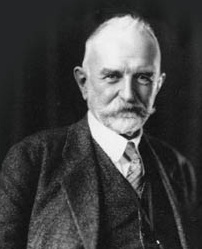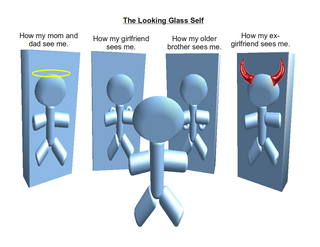Related Research Articles

In sociology, socialization is the process of internalizing the norms and ideologies of society. Socialization encompasses both learning and teaching and is thus "the means by which social and cultural continuity are attained".

Erving Goffman was a Canadian-born American sociologist, social psychologist, and writer, considered by some "the most influential American sociologist of the twentieth century".

Symbolic interactionism is a sociological theory that develops from practical considerations and alludes to humans' particular use of shared language to create common symbols and meanings, for use in both intra- and interpersonal communication. According to Macionis, symbolic interactionism is "a framework for building theory that sees society as the product of everyday interactions of individuals". In other words, it is a frame of reference to better understand how individuals interact with one another to create symbolic worlds, and in return, how these worlds shape individual behaviors. It is a framework that helps understand how society is preserved and created through repeated interactions between individuals. The interpretation process that occurs between interactions helps create and recreate meaning. It is the shared understanding and interpretations of meaning that affect the interaction between individuals. Individuals act on the premise of a shared understanding of meaning within their social context. Thus, interaction and behavior is framed through the shared meaning that objects and concepts have attached to them. From this view, people live in both natural and symbolic environments.

George Herbert Mead was an American philosopher, sociologist, and psychologist, primarily affiliated with the University of Chicago. He was one of the key figures in the development of pragmatism. He is regarded as one of the founders of symbolic interactionism, and was an important influence on what has come to be referred to as the Chicago School of Sociology.

In micro-sociology, interactionism is a theoretical perspective that sees social behavior as an interactive product of the individual and the situation. In other words, it derives social processes from social interaction, whereby subjectively held meanings are integral to explaining or understanding social behavior.
Impression management is a conscious or subconscious process in which people attempt to influence the perceptions of other people about a person, object or event by regulating and controlling information in social interaction. It was first conceptualized by Erving Goffman in 1959 in The Presentation of Self in Everyday Life, and then was expanded upon in 1967.

Charles Horton Cooley was an American sociologist. He was the son of Michigan Supreme Court Judge Thomas M. Cooley. He studied and went on to teach economics and sociology at the University of Michigan. He was a founding member of the American Sociological Association in 1905 and became its eighth president in 1918. He is perhaps best known for his concept of the looking-glass self, which is the concept that a person's self grows out of society's interpersonal interactions and the perceptions of others. Cooley's health began to deteriorate in 1928. He was diagnosed with an unidentified form of cancer in March 1929 and died two months later.

This is an index of sociology articles. For a shorter list, see List of basic sociology topics.
Herbert George Blumer was an American sociologist whose main scholarly interests were symbolic interactionism and methods of social research. Believing that individuals create social reality through collective and individual action, he was an avid interpreter and proponent of George Herbert Mead's social psychology, which he labeled symbolic interactionism. Blumer elaborated and developed this line of thought in a series of articles, many of which were brought together in the book Symbolic Interactionism. An ongoing theme throughout his work, he argued that the creation of social reality is a continuous process. Blumer was also a vociferous critic of positivistic methodological ideas in sociology.

Dramaturgy is a sociological perspective that analyzes micro-sociological accounts of everyday social interactions through the analogy of performativity and theatrical dramaturgy, dividing such interactions between "actors", "audience" members, and various "front" and "back" stages.
Internet identity (IID), also online identity, online personality, online persona or internet persona, is a social identity that an Internet user establishes in online communities and websites. It may also be an actively constructed presentation of oneself. Although some people choose to use their real names online, some Internet users prefer to be anonymous, identifying themselves by means of pseudonyms, which reveal varying amounts of personally identifiable information. An online identity may even be determined by a user's relationship to a certain social group they are a part of online. Some can be deceptive about their identity.
The 'I' and the 'me' are terms central to the social philosophy of George Herbert Mead, one of the key influences on the development of the branch of sociology called symbolic interactionism. The terms refer to the psychology of the individual, where in Mead's understanding, the "me" is the socialized aspect of the person, and the "I" is the active aspect of the person.

Eszter Hargittai is a communication studies scholar and Professor at the University of Zurich.

The term looking-glass self was created by American sociologist Charles Horton Cooley in 1902, and introduced into his work Human Nature and the Social Order. It is described as our reflection of how we think we appear to others. Cooley takes into account three steps when using "the looking glass self". Step one is how one imagines one looks to other people. Step two is how one imagines the judgment of others based on how one thinks they view them. Step three is how one thinks of how the person views them based on their previous judgments.
The social penetration theory (SPT) proposes that as relationships develop, interpersonal communication moves from relatively shallow, non-intimate levels to deeper, more intimate ones. The theory was formulated by psychologists Irwin Altman of the University of Utah and Dalmas Taylor of the University of Delaware in 1973 to understand relationship development between individuals. Altman and Taylor noted that relationships "involve different levels of intimacy of exchange or degree of social penetration". SPT is known as an objective theory as opposed to an interpretive theory, meaning it is based on data drawn from actual experiments and not simply from conclusions based on individuals' specific experiences.
Social conditioning is the sociological process of training individuals in a society to respond in a manner generally approved by the society in general and peer groups within society. The concept is stronger than that of socialization, which is the process of inheriting norms, customs and ideologies. Manifestations of social conditioning are vast, but they are generally categorized as social patterns and social structures including nationalism, education, employment, entertainment, popular culture, religion, spirituality and family life. The social structure in which an individual finds him or herself influences and can determine their social actions and responses.

Deviance or the sociology of deviance explores the actions and/or behaviors that violate social norms across formally enacted rules as well as informal violations of social norms. Although deviance may have a negative connotation, the violation of social norms is not always a negative action; positive deviation exists in some situations. Although a norm is violated, a behavior can still be classified as positive or acceptable.

Social information processing theory, also known as SIP, is a psychological and sociological theory originally developed by Salancik and Pfeffer in 1978. This theory explores how individuals make decisions and form attitudes in a social context, often focusing on the workplace. It suggests that people rely heavily on the social information available to them in their environments, including input from colleagues and peers, to shape their attitudes, behaviors, and perceptions.
In sociology and other social sciences, internalization means an individual's acceptance of a set of norms and values through socialisation.
Context collapse or "the flattening of multiple audiences into a single context" is a term arising out of the study of human interaction on the internet, especially within social media. Context collapse "generally occurs when a surfeit of different audiences occupy the same space, and a piece of information intended for one audience finds its way to another" with that new audience's reaction being uncharitable and highly negative for failing to understand the original context.
References
- ↑ John O'Neill, Sociology as a Skin Trade (London 1972) p. 169
- ↑ Lars Udehn, Methodological Individualism (2001) p. 367n
- ↑ Nicholas Phillipson, Adam Smith: An Enlightened Life (2011) p. 107
- ↑ Quoted in Phillipson, pp. 164–5
- ↑ George H. Mead, Mind, Self, and Society (Chicago 1962) pp. 159, 154
- ↑ Mead, p. 155
- ↑ Mead, pp. 160, 154
- ↑ F. C. da Silva, G. H. Mead (2007) p. 50
- ↑ Mead, p. 322
- ↑ da Silva, pp. 50–1
- ↑ Johannes Voelz, Transcendental Resistance (2010) p. 131
- ↑ Duane Rousselle, (2019) Jacques Lacan and American Sociology Palgrave
- ↑ Vincent Crapanzano, Hermes' Dilemma and Hamlet's Desire (1992) pp. 88–9
- ↑ Litt, Eden; Hargittai, Eszter (2016-01-01). "The Imagined Audience on Social Network Sites". Social Media + Society. 2 (1): 205630511663348. doi: 10.1177/2056305116633482 . ISSN 2056-3051. S2CID 147168829.
- ↑ Vickery, Jacqueline Ryan (2014-12-03). "'I don't have anything to hide, but … ': the challenges and negotiations of social and mobile media privacy for non-dominant youth". Information, Communication & Society. 18 (3): 281–294. doi:10.1080/1369118x.2014.989251. ISSN 1369-118X. S2CID 143042947.
- ↑ Pitcan, Mikaela; Marwick, Alice E.; boyd, danah (2018), "Performing a Vanilla Self: Respectability Politics, Social Class, and the Digital World", Social Media & the Self: An Open Reader, Bethlehem, PA: mediastudies.press, doi: 10.32376/3f8575cb.a06df9b7 , ISBN 978-1-951399-04-7 , retrieved 2021-10-12
- ↑ Ellison, Nicole; Heino, Rebecca; Gibbs, Jennifer (January 2006). "Managing Impressions Online: Self-Presentation Processes in the Online Dating Environment". Journal of Computer-Mediated Communication. 11 (2): 415–441. doi: 10.1111/j.1083-6101.2006.00020.x . ISSN 1083-6101.
- ↑ Brym, Robert J. (2001). Love online : a report on digital dating in Canada. [publisher not identified]. OCLC 234084178.